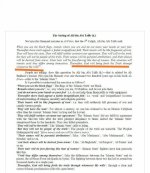But the hadith about the Sign of Qiyamah is authentic-
Itha ra’aitun mecca bu’ijat katha’ima, wa ya-tasawa bunyanuha ru’usa jibaliha, faqad athalati as-Sa’atu.
When you see Mecca, its mountain with holes (pierced through them), and its buildings reach its mountain tops, then as-Sa’ah (the Hour) has already cast its shadow.
[Suyuti]
The Hadiyth has both literal and metaphorical implications. The metaphorical implication is that the Hour has already cast its shadow means that the Hour is approaching, as Imam Suyuti has explained.
When the Mecca Clock Tower was built in 2012, it reached, or even surpassed, the mountain tops of Mecca. And, the Hadiyth says that when you see the buildings in Mecca reach (or surpass) the mountain tops, then the Hour has already cast its shadow, i.e. this is a sign that the Hour is near (close by).
The Clock Tower is also called Burj as-Sa’ah, one of the meanings of as-Sa’ah is the Clock. The Clock Tower actually casts its shadow over the Kaba. So, in a literal fulfilment of the prophecy, as-Sa’ah (the Clock) has already cast its shadow (over the Kaba).
The Clock Tower is a disrespect to the Kaba, in two-folds: it dwarfs the Kaba, and also it casts its shadow over the Kaba.
In the above Hadiyth it was stated that the buildings in Mecca will reach its mountain tops. In a variation of this Hadiyth it is stated that the buildings in Mecca will surpass its mountain tops, the Hadiyth is as follows:
فإذا رأيت مكة قد بعجت كظائم ورأيت البناء يعلو رءوس الجبال فاعلم أن الأمر قد أظلكo
So when you see in Makkah that channels have already been dug (or tunnels built), and you see the buildings surpass the tops of the mountains, then know that the command (of the Hour) has already cast its shadow over you.
[Narrated by Ibn Abi Shaybah in Al-Musannaf, Hadiyth-124]
And, with a slight variation in another Hadiyth:
إِذَا رَأَيْتَ مَكَّةَ قَدْ بُعِجَتْ كِظَامًا وَرَأَيْتَ الْبِنَاءَ قَدْ عَلا عَلَى رُءُوسِ الْجِبَالِ ، فَاعْلَمْ أَنَّ الأَمْرَ قَدْ أَظَلَّكَ-o-
When you see in Makkah, that already its mountains are with holes (pierced through them), and you see that the buildings have already surpassed over the tops of the mountain, then know that the command (of the Hour) has already cast its shadow over you (or the matter is close at hand).
[Narrated by Al-Azraqi in the Book of reports about Makkah – Kitab Akhbaar Makkah, Hadiyth-1724]
And, with a slight variation in another Hadiyth:
إِذَا رَأَيْتَ الْمَاءَ بِطَرِيقِ مَكَّةَ وَرَأَيْتَ الْبِنَاءَ يَعْلُو أَخْشَبَيْهَا ، فَخُذْ حِذْرَكَ-o
When you see the belly of Makkah will be cleft open and through it will be dug out river-like passages (i.e. tunnels) (or water in the road to Makkah), and you see the buildings surpass its mountains, then take care (or beware, or a variant has: then know that the matter is at hand, or then understand that the time of trial (Judgment day) is near at hand).
[Narrated by Al-Azraqi in the Book of reports about Makkah – Kitab Akhbaar Makkah, Hadiyth-1725;
Nu`aym b. Hammad in Kitab al-Fitan 1:43 no. 59 (with its chain);
Ibn Hajar al-Asqalani in Fath al-Bari: Kitab al-Hajj, Bab ayna yusalli al-zuhra yawma al-tarwiya, and he sourced it to al-Fakihi’s Tarikh Makkah;
Ibrahim al-Harbi in Gharib al-Hadiyth]
In all of the above narrations it states about – the mountains having holes (pierced/drilled through them), or the channels have already been dug, or the belly of Makkah will be cleft open and through it will be dug out river-like passages, or water in the road to Makkah, or tunnels built in Makkah; all of these prophecies simultaneously hold good, this is how:
These statements refer to the tunnels going through the mountains in Makkah, so we have the description of holes being pierced/drilled through the mountains. These tunnels are used by both pedestrians and vehicles.
The word ‘tunnels built in Makkah’ also refers to tunnels under the mountains of Makkah and beneath the ground, (such as those made for the) huge pipes, (which carry) Zamzam water.
Source-
https://googleweblight.com/i?u=http...he-hour-has-already-cast-its-shadow/&hl=en-IN
